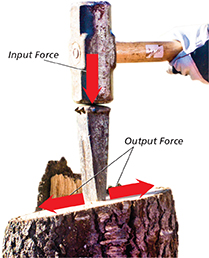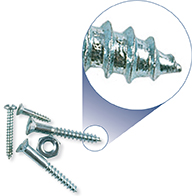Gently sloping trails and roads are also a type of simple machine—an inclined plane. An inclined plane is a slanted surface along which a force moves an object to a different elevation. The ramp that makes a refrigerator easier to lift into a truck is an inclined plane. So are the wheelchair ramps used in front of buildings. The distance along the ramp is its input distance, whereas the change in height of the ramp is its output distance.  The ideal mechanical advantage of an inclined plane is the distance along the inclined plane divided by its change in height. For example, a 6-meter-long ramp that gains 1 meter of height has an ideal mechanical advantage of 6.
The ideal mechanical advantage of an inclined plane is the distance along the inclined plane divided by its change in height. For example, a 6-meter-long ramp that gains 1 meter of height has an ideal mechanical advantage of 6.
Wedges and Screws
Wedges and screws are similar to inclined planes because both involve sloping surfaces. A key difference, however, is that wedges and screws have sloping surfaces that move.
Figure 16 The wedge being used to split the log consists of two inclined planes that slope toward each other. The inclined planes force the wood fibers apart as the wedge is driven into the log. Relating Cause and Effect What is the cause of the forces, exerted by the wedge, that split the log apart?

Wedges
A wedge is a V-shaped object whose sides are two inclined planes sloped toward each other. Figure 16 shows a type of wedge often used to split wood. A sledgehammer drives the wedge into the log. As the wedge is driven in, its sloping sides push the wood on either side a small distance apart. This gives a wedge a mechanical advantage greater than 1. The thinner a wedge is relative to its length, the less the wedge separates the wood fibers as it moves through the log.  A thin wedge of a given length has a greater ideal mechanical advantage than a thick wedge of the same length. Other examples of wedges are a knife blade, which cuts best when its edge is sharp, and a zipper, which uses a wedge to separate and join the zipper's teeth.
A thin wedge of a given length has a greater ideal mechanical advantage than a thick wedge of the same length. Other examples of wedges are a knife blade, which cuts best when its edge is sharp, and a zipper, which uses a wedge to separate and join the zipper's teeth.
Screws
A screw, as shown in Figure 17, is an inclined plane wrapped around a cylinder. For two screws of the same length, the one whose threads are closer together moves forward less for each turn of the screw.  Screws with threads that are closer together have a greater ideal mechanical advantage.
Screws with threads that are closer together have a greater ideal mechanical advantage.
The thread on a screw is usually measured in threads per inch or threads per centimeter. A screw with fewer threads per inch takes fewer turns to drive into a piece of wood or other material. But the smaller mechanical advantage of the screw requires you to exert a greater input force in order to drive it in. Other common examples of the screw include nuts, which have the threads on the inside, and bolts.
Figure 17 A screw is a simple machine made up of an inclined plane wrapped around a cylinder.






 How is a screw similar to an inclined plane?
How is a screw similar to an inclined plane?